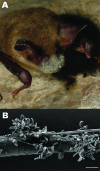White-nose syndrome fungus (Geomyces destructans) in bats, Europe
- PMID: 20678317
- PMCID: PMC3298319
- DOI: 10.3201/eid1608.100002
White-nose syndrome fungus (Geomyces destructans) in bats, Europe
Abstract
White-nose syndrome is an emerging disease in North America that has caused substantial declines in hibernating bats. A recently identified fungus (Geomyces destructans) causes skin lesions that are characteristic of this disease. Typical signs of this infection were not observed in bats in North America before white-nose syndrome was detected. However, unconfirmed reports from Europe indicated white fungal growth on hibernating bats without associated deaths. To investigate these differences, hibernating bats were sampled in Germany, Switzerland, and Hungary to determine whether G. destructans is present in Europe. Microscopic observations, fungal culture, and genetic analyses of 43 samples from 23 bats indicated that 21 bats of 5 species in 3 countries were colonized by G. destructans. We hypothesize that G. destructans is present throughout Europe and that bats in Europe may be more immunologically or behaviorally resistant to G. destructans than their congeners in North America because they potentially coevolved with the fungus.
Figures


Similar articles
-
Histopathology confirms white-nose syndrome in bats in Europe.J Wildl Dis. 2012 Jan;48(1):207-11. doi: 10.7589/0090-3558-48.1.207. J Wildl Dis. 2012. PMID: 22247393
-
Increasing incidence of Geomyces destructans fungus in bats from the Czech Republic and Slovakia.PLoS One. 2010 Nov 5;5(11):e13853. doi: 10.1371/journal.pone.0013853. PLoS One. 2010. PMID: 21079781 Free PMC article.
-
Inoculation of bats with European Geomyces destructans supports the novel pathogen hypothesis for the origin of white-nose syndrome.Proc Natl Acad Sci U S A. 2012 May 1;109(18):6999-7003. doi: 10.1073/pnas.1200374109. Epub 2012 Apr 9. Proc Natl Acad Sci U S A. 2012. PMID: 22493237 Free PMC article.
-
Investigating and managing the rapid emergence of white-nose syndrome, a novel, fatal, infectious disease of hibernating bats.Conserv Biol. 2011 Apr;25(2):223-31. doi: 10.1111/j.1523-1739.2010.01638.x. Epub 2011 Feb 1. Conserv Biol. 2011. PMID: 21284732 Review.
-
Ecology and impacts of white-nose syndrome on bats.Nat Rev Microbiol. 2021 Mar;19(3):196-210. doi: 10.1038/s41579-020-00493-5. Epub 2021 Jan 18. Nat Rev Microbiol. 2021. PMID: 33462478 Review.
Cited by
-
Effect of Trans, Trans-Farnesol on Pseudogymnoascus destructans and Several Closely Related Species.Mycopathologia. 2015 Dec;180(5-6):325-32. doi: 10.1007/s11046-015-9921-2. Epub 2015 Jul 11. Mycopathologia. 2015. PMID: 26162644
-
Nutritional capability of and substrate suitability for Pseudogymnoascus destructans, the causal agent of bat white-nose syndrome.PLoS One. 2013 Oct 21;8(10):e78300. doi: 10.1371/journal.pone.0078300. eCollection 2013. PLoS One. 2013. PMID: 24205191 Free PMC article.
-
White-Nose Syndrome Fungus in a 1918 Bat Specimen from France.Emerg Infect Dis. 2017 Sep;23(9):1611-1612. doi: 10.3201/eid2309.170875. Emerg Infect Dis. 2017. PMID: 28820367 Free PMC article.
-
Bats Increase the Number of Cultivable Airborne Fungi in the "Nietoperek" Bat Reserve in Western Poland.Microb Ecol. 2016 Jul;72(1):36-48. doi: 10.1007/s00248-016-0763-3. Epub 2016 Apr 15. Microb Ecol. 2016. PMID: 27084554 Free PMC article.
-
First Isolation of Pseudogymnoascus destructans, the Fungal Causative Agent of White-Nose Disease, in Bats from Italy.Mycopathologia. 2019 Oct;184(5):637-644. doi: 10.1007/s11046-019-00371-6. Epub 2019 Aug 14. Mycopathologia. 2019. PMID: 31414314
References
-
- Reichard JD, Kunz TH. White-nose syndrome inflicts lasting injuries to the wings of little brown myotis (Myotis lucifugus). Acta Chiropt. 2009;11:457–64. 10.3161/150811009X485684 - DOI
-
- Turner GR, Reeder DM. Update of white-nose syndrome in bats, September 2009. Bat Research News. 2009;50:47–53.
-
- United States Geological Survey. Update on white-nose syndrome: Tennessee finding. USGS wildlife health bulletin. Reston (VA): The Survey; 2010. [cited 2010 May 19]. http://www.nwhc.usgs.gov/disease_information/white-nose_syndrome/
Publication types
MeSH terms
Substances
LinkOut - more resources
Full Text Sources
Molecular Biology Databases
